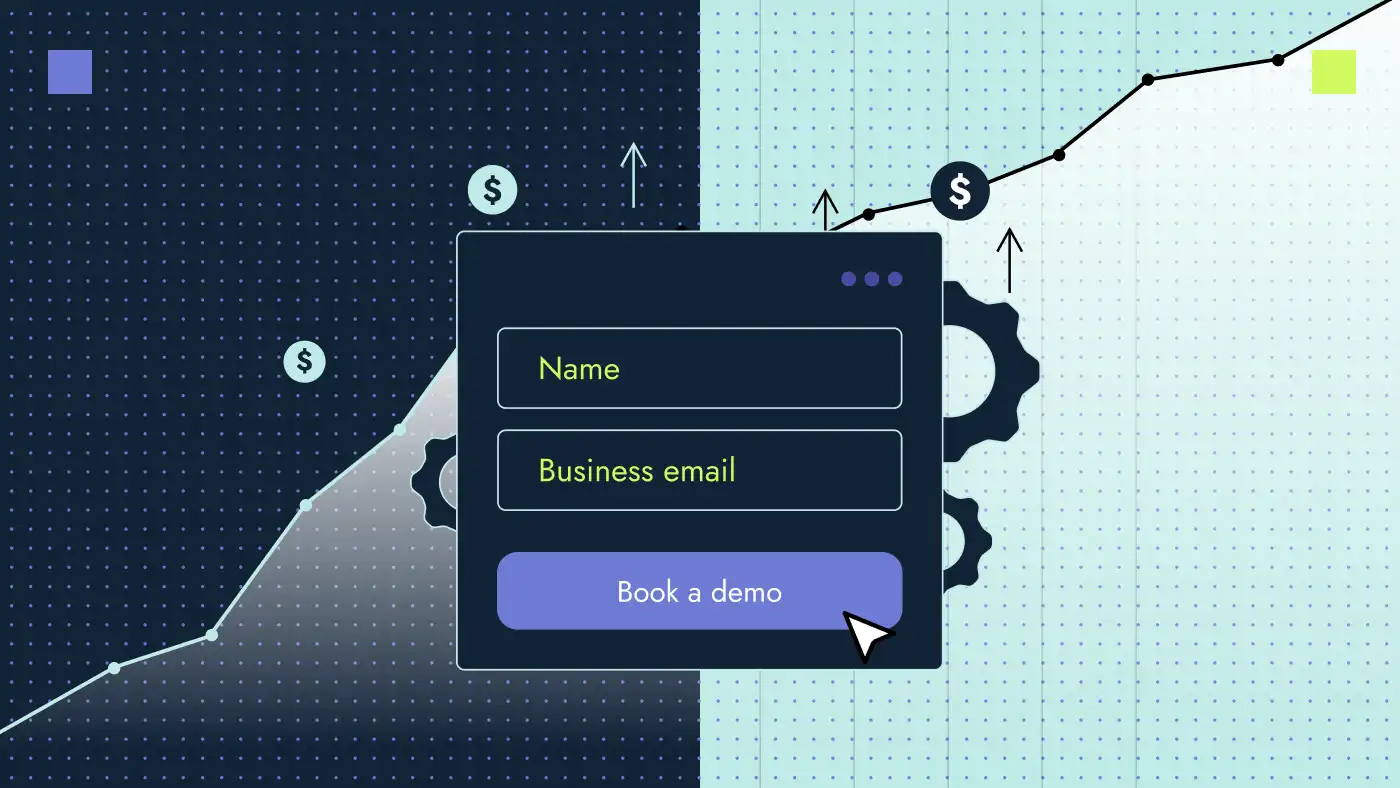Whether you’re a seasoned entrepreneur or just launching your first B2B SaaS product, the make-or-break factor for any business lies in converting leads into valuable customers. While increasing demo signups directly improves sales, not all your website visitors get converted into booked demos.
To boost user signups, your sales process should focus on capturing the interest of potential users and motivating them to take the next step. Here are 11 digital marketing tactics on how to increase demo requests:
1. Create buyer personas
Buyer personas provide insights into how your product or service fits into the lives or workflows of your ideal customers. This understanding allows you to position your demo as a critical step in solving their specific challenges and achieving their goals.
Knowing the preferred communication channels of your personas helps optimize your SaaS marketing efforts and budget spending. Whether through SEO blog posts or targeted pay-per-click ads, reaching your audience on the platforms they frequent increases the visibility of your SaaS product demo request opportunities.
2. Understand buying phases
A report by the Content Marketing Institute found that 61% of B2B organizations face the challenge of creating content that appeals to different stages of the buyer’s journey.
By recognizing the different stages of decision-making that potential customers go through, you tailor your marketing approach to meet their specific needs at each point of the sales funnel. That has been the case with LMS provider LearnWorlds, which increased their demo button clicks by more than 100% by outputting content targeting high-value topics across every stage of the buyer journey.
Let’s review how to boost website sales during the different stages of a B2B buyer journey.
| Stage | What it means | Marketing strategies |
|---|---|---|
| Awareness | Potential customers become aware of their challenges or needs. | Tailor your marketing efforts to educate prospects about the existence of your solution. Use content marketing, SEO, email campaigns and advertising to highlight the problems your offering solves. |
| Consideration | Prospects actively seek information and evaluate different solutions. | Provide detailed content to highlight key features and benefits that address specific pain points. This content guides users toward considering a demo as a valuable next step for a deeper understanding. |
| Decision | Prospects are close to making a decision and are comparing specific features, pricing or additional offerings. | Showcase the value of your product or service through case studies and testimonials. Make it clear how a demo offers an in-depth look at what sets your solution apart. |
| Action (Signup) | Prospects are ready to take the next step — signing up for a demo. | Simplify the demo signup process and clearly communicate the benefits of requesting a demo. Align your messaging with your audience's specific needs and concerns at this critical decision making juncture. |
📚 Keep learning:
3. Leverage SEO-driven content marketing
A well-crafted content marketing strategy generates awareness, engages your target audience and drives them through the sales funnel, ultimately leading to the demo request form.
You help potential customers understand how your solution addresses their specific needs through in-depth guides, product-focused blog posts or explainer videos, creating curiosity and interest in a live demo.
Thought leadership
Consistently produce well-researched and high-quality content to create a brand perception of being an authority in your industry. When potential customers perceive you as an industry expert, they are more inclined to trust your solutions and visit your “request a demo page” to see how your expertise translates into a practical product or service.
One of our cybersecurity clients increased demo form submissions by 50% by targeting long-tail keywords and increasing qualified traffic. How? By outputting thought leadership cybersecurity content, enriching landing pages and optimizing CTAs. Increased B2B demo requests contributed to driving over $7M in deal opportunities in 18 months.
Gated resources
Your SaaS writing strategy should focus on providing real value to your target audience. It could be in the form of whitepapers, ebooks, industry reports or other resources that address common pain points or challenges within your industry. Place these resources behind a form that requires users to provide their contact information, such as name and email address, before accessing the content.
Here’s an example from parcelLab, which asks for user contact before providing access to research reports.
💡Pro tip: Once users access the gated content, initiate an email nurturing campaign encouraging them to explore your product through a demo.
Webinars
To position yourself as an authority, plan and conduct webinars that delve into industry trends, best practices or solutions to common customer challenges. Share exclusive insights and data during the webinar to make attendees feel they are gaining access to valuable information not readily available elsewhere.
Take a look at how Armis not only highlights what the webinar is about but also allows visitors to watch it later by filling up the form.
💡 Pro tip: Integrate product demonstrations within your webinars and showcase how your solutions address the pain points discussed during the session.
Case studies
By integrating case studies into your content marketing strategy, you provide tangible evidence of your solutions’ effectiveness.
Develop case studies with compelling narratives that outline:
- Challenges faced by your clients
- Solutions implemented
- Positive outcomes achieved
You can take inspiration from our B2B case studies page to understand how we demonstrate the versatility of our offerings.
💡 Pro tip: Make sure to emphasize quantifiable results, such as increased efficiency, cost savings or revenue growth. You should also integrate client testimonials within your case studies to add authenticity and build trust. Let your clients speak to the positive experiences they’ve had with your solutions.
SEO
Simply developing resonating content is not enough if your target audience can’t find your website. You need SEO to increase the visibility and accessibility of your content on the search engine results page (SERP). In fact, Hubspot reports that 88% of marketers plan to increase or maintain their SEO investment in 2024.
Here’s a breakdown of how to use SEO for lead generation.
- Keyword research: Target specific B2B keywords relevant to your services to ensure you attract targeted traffic that is more likely to convert for booking demos. Prioritize long tail keywords that align with specific topics addressed in your content.
- On-page elements: Use target keywords in titles, headers, meta descriptions and throughout the body of the content. Use descriptive file names for images and add alt text to improve accessibility.
- Link building: Acquire high-quality backlinks from reputable sources within your industry. In addition to external links, interlink your sales enablement content to create a network of related articles.
- Technical optimization: Look at the technical aspects of your website (Core Web Vitals metrics, sitemap, page speed and load time etc). You should also ensure that your site is optimized for mobile devices.
- Schema markup: Implement schema markup to provide search engines with additional information about your content.
📚 Keep learning:
4. Design a compelling user experience
Creating a positive and engaging journey for users from the moment they land on your website decides the fate of whether they will request a demo and ultimately buy your product.
A user-friendly website navigation structure reduces friction and customer frustration, increasing the likelihood of users staying on your site and signing up. Visual elements, such as high-quality images and consistent branding, contribute to the overall appeal of your website.
Consider the example of Grammarly and what it is doing right. The AI-powered writing assistant focuses on an intuitive layout, with a well-organized structure that guides users through the key features and benefits of the product. It maintains consistent branding elements throughout its site, including colors, fonts and imagery.
5. Optimize BOFU pages for conversion
The bottom of the funnel (BOFU) is the stage where potential customers actively consider making a purchase and are looking for information that will help them finalize their decision. BOFU content often addresses questions related to pricing, product details and how the solution meets the customer’s unique requirements.
Each BOFU page is a crucial step in the user journey, leading them closer to the demo page. Optimizing these milestones increases the likelihood of users requesting a B2B SaaS demo. Here’s how to optimize different BOFU pages:
Home page
Optimizing the home page is about creating a welcoming and user-friendly entry point to your website.
- Captivating design: Ensure a captivating design that encourages exploration. Incorporate a balance of white space and design elements to avoid overwhelming visitors.
- Page load speed: Optimize page speed to prevent potential visitors from bouncing. A slow-loading page frustrates users and leads to abandonment.
- User-friendly interface (UI): Prioritize a user-friendly interface with intuitive navigation. The easier it is for visitors to navigate the website, the more likely they are to explore further.
- Branding elements: Maintain consistent branding elements, including colors, typography and font size, to reinforce your brand identity and create a cohesive user experience.
- Compelling copy: Craft copy that communicates your products’ main value proposition concisely. Use language that resonates with your audience.
Here’s an example of how Brinqa uses these elements to engage users from the moment they land on the website.
Top feature pages
The features pages provide visitors with detailed information about your product or service’s specific capabilities and functionalities.
- User-centric messaging: Focus on how your product solves the user’s problems rather than diving into jargon and technical details. Use language that is easy to understand and relatable.
- Visual hierarchy: Create a visual hierarchy using font sizes and clear headings. Guide users through the content, emphasizing key features that align with user benefits.
- Navigation clarity: Implement a clear navigation structure to help users understand where they are on your site and how to read about each product’s features in detail.
Here’s an example of how Box, a cloud document storage platform, highlights the key features of its products so the readers know the key benefits of each product.
Pricing page
Your prospects cross the home page milestone, explore the feature pages and head towards your pricing page before signing up for a demo. That’s how your pricing page will make the cut:
- Memorable plan names: Name your plans in a unique way that reflects their value. Make it easy for visitors to recall and compare different pricing tiers.
- Anchoring technique: Use the anchoring technique by positioning a higher-priced tier to make other tiers appear more affordable. This approach can influence decision-making.
- Scannable content: List only key features on the pricing page to make it easily scannable. Highlight the most relevant information to help users make informed decisions.
Here’s an example from LearnWorlds, which includes different plans to highlight their price and key features.
Competitor comparison pages
If your customers are weighing you against another provider, a competitor comparison page guides them toward choosing your product or service over competitors.
- Highlight USP: Clearly define your unique selling proposition (USP) and center your narrative around it. Showcase why your product stands out compared to competitors.
- Focus on key features: Concentrate on the most important product features directly addressing user needs. Avoid overwhelming users with excessive details.
- User testimonials: Leverage software marketplace reviews and customer testimonials to support your claims. Real user experiences add credibility to your comparison.
- Play a fair game: Do not boast at length about your product or take a jibe at your competitors. Make sure to answer your prospect’s key question, “Is your product better suited for them than your competitor’s?”
In this example, SaaS Alerts uses comparison pages to highlight why it’s the best alternative among its competitors.
6. Retarget users with email campaigns
Engaging visitors who didn’t complete a sale is a strategic move for qualified lead generation. Retargeting emails reach users who previously visited your website but didn’t take the desired action of signing up for a product demo.
As a general rule, the more expensive and complicated the product, the more time people need to make a decision. Engage them through newsletters or email campaigns before you ask for the sale and convert them into users. SalesCycle found that email marketing generates an average global conversion rate of around 27.45%, underscoring the effectiveness of emails as a marketing tool.
In your email campaign, share behind-the-scenes content, introduce your team or use storytelling to humanize your brand. While many AI writing tools are available in the market, human-led content increases the likability and trust of your website. Both factors play a significant role in the decision to move forward with a purchase.
7. Add live chat to your site
One of the top mantras in sales is that “customers want to feel listened to.” And that’s what a live chat feature offers. Promptly addressing customer queries leaves them happy and positively affects their purchase decisions.
If visitors have hesitations about your product or service, live chat helps you provide clarity and build confidence in their decision to sign up for a demo. You can also integrate a timely pop-up in your live chat option, asking visitors if they want help from your sales team.
Our live chat option helps visitors start a personalized conversation with our sales team and ask queries about the services they are interested in.
Integrate live chat with CRM systems to manage leads and increase demo bookings. Live chat interactions gather information about the lead’s needs, pain points and budget. The CRM software then assigns a lead score, helping sales teams prioritize high-value leads and focus efforts on those more likely to convert. It also triggers follow-up actions after live chat interactions to encourage demo requests.
8. Use popups on your website
Popups are small, overlay windows that appear on top of a web page’s content. They capture the attention of visitors and prompt them to take a specific action, such as downloading a resource or signing up for demos.
To make sure you don’t annoy your visitors with a popup every time they land on your website, you can set the following triggers for popups:
- After a user spends a certain amount of time on the site
- The user scrolls to a particular section
- They are about to leave the website
You can also trigger demo forms as a popup once a user clicks on the CTA. Take inspiration from Sedna, who uses popups for their B2B SaaS demo form, providing a smoother transition without redirecting users to a separate webpage.
9. Write engaging calls to action
If you want more signups, make actionable CTAs and don’t hide them on your page. Add one to the header section and another one towards the end of your landing page.
Take a look at how we place our “Become a client” CTA in the hero section of our website as it’s one of the first elements users see. This clarity reduces confusion and encourages immediate engagement.
In the footer section, we have a contact form to provide visitors with a quick and accessible way to get in touch. Collecting essential information like name and email allows us to generate leads and initiate follow-up communications.
Draft clear and persuasive calls to action that explicitly communicate the value of requesting a B2B product demo. Using action-oriented language prompts visitors to take the crucial step in engaging with your product or service. Instead of generic phrases like “Submit” or “Click Here,” use language that directly conveys the action, such as:
- Request a demo
- Book a demo
- Get a demo
- See it in action
- Contact us
10. Eliminate noise in your B2B SaaS demo form
As you approach the final steps of your sales process, simplify your screen. For a compelling UX in the demo signup form, minimize the number of fields, provide clear instructions and make the process as straightforward as possible to encourage signups.
When users reach the checkout, eliminate anything on the page that doesn’t directly increase conversion.
Here’s an example from Lattice, which effectively communicates the value its HR software brings to potential customers. The demo form has limited fields to reduce friction for visitors, making it quick and easy for them to sign up. This strategy aligns with Omnisend’s findings that three is the ideal number of converting form fields, with an average conversion rate of 10%.
11. Build a user community
A user community provides a platform for current customers to share their positive experiences and recommendations.
Select the right platform for your community — a dedicated forum on your website, a private LinkedIn group or even a community space on platforms like Slack or Discord. Make sure your team actively participates in the community, so the users have direct access to product experts and influencers within your company. When potential users see active community members discussing and endorsing your product, they are more likely to develop trust and explore it further by signing up for product demos.
A great example comes from the Styra Community on Slack, where developers are able to leave their questions about OPA, interacting directly with members of the Styra team. The company also uses this direct communication channel to make announcements about the product.
Increase website demos with Productive Shop
If you’re a B2B SaaS business looking to increase demo bookings, reach out to us.
From an optimized user experience and pixel-perfect website design to a targeted B2B SEO strategy and resonating sales enablement content, you get what you need to attract, nurture and convert the right people at the right time of their buyer journey.
Book a consultation to get those SaaS product demo requests rolling in.





















